
Pellaea is a genus of ferns in the Cheilanthoideae subfamily of the Pteridaceae. The genus name is derived from the Greek word πελλος (pellos), meaning "dark," and refers to the brown stems. Many members of the genus are commonly known as cliffbrakes. They primarily grow in rocky habitats, including moist rocky canyons, slopes, and bluffs.
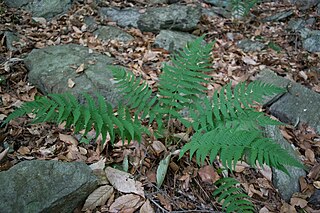
Dryopteris marginalis, vernacularly known as the marginal shield fern or marginal wood fern, is a perennial species of fern found in damp shady areas throughout eastern North America, from Texas to Minnesota and Newfoundland. It favors moderately acid to circumneutral soils in cooler areas but is fairly drought-resistant once established. In the warmer parts of its range, it is most likely to be found on north-facing non-calcareous rock faces. It is common in many altitudes throughout its range, from high ledges to rocky slopes and stream banks. Marginal wood fern's name derives from the fact that the sori are located on the margins, or edges of the leaflets.

Pellaea andromedifolia, with the common names coffee cliffbrake and coffee fern, is a species of cliff brake fern in the Cheilanthoideae subfamily of the Pteridaceae. It is native to California in the United States and Baja California in Mexico.
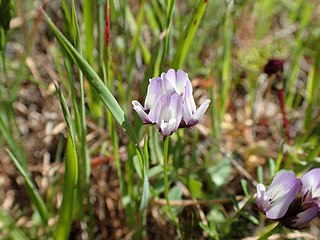
Astragalus breweri is a species of milkvetch known by the common name Brewer's milkvetch. It is endemic to northern California, where it is found in several counties surrounding the north edge of the San Francisco Bay Area. It grows in open habitat in the North Coast Ranges, sometimes on serpentine soils.
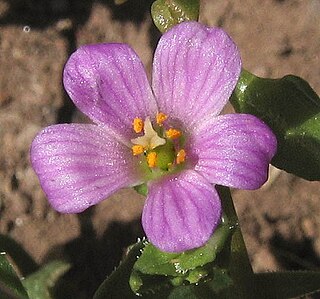
Calandrinia breweri is a species of flowering plant in the family Montiaceae known by the common name Brewer's redmaids.

Cardamine breweri is a species of cardamine known by the common name Brewer's bittercress. It is native to western North America from British Columbia to California to Colorado, where it grows in coniferous forests, particularly in wet bog habitats.
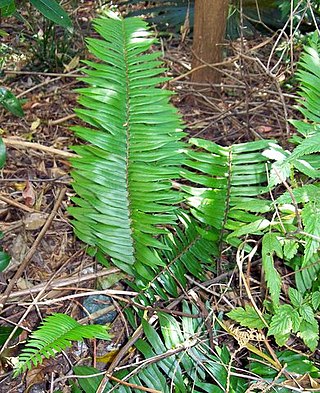
Pellaea falcata, the sickle fern, is a widespread and common plant, growing in eastern Australia. It is often seen in on the coast and ranges in eucalyptus forest and rainforest. It grows in Tasmania, Victoria, New South Wales, Queensland, and Lord Howe Island.

Pellaea brachyptera is a species of fern known by the common name Sierra cliffbrake. It is native to the coastal and inland mountains of northern California and Oregon, and a disjunct population was discovered in Chelan County, Washington, in 1986.
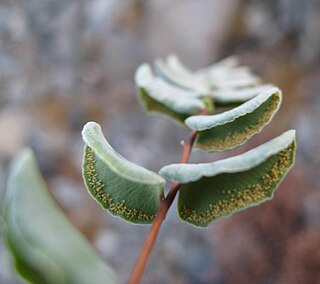
Pellaea bridgesii is a species of fern known by the common name Bridges' cliffbrake. It is native to an area of the western United States from northern California to Idaho, where it grows in rocky granitic cliffs and slopes.
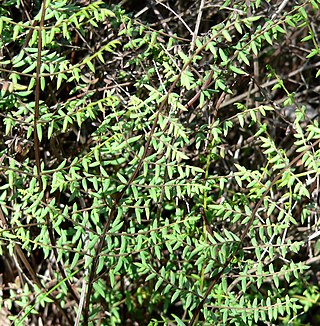
Pellaea mucronata is a species of fern known by the common name bird's foot cliffbrake.

Pellaea truncata is a species of fern known by the common name spiny cliffbrake. It is native to the southwestern United States and northern Mexico, where it grows in rocky areas, such as cliffs and slopes.

Pellaea glabella is a fern with the common name smooth cliffbrake. It was once regarded as a reduced form or variety of Pellaea atropurpurea. P. glabella is known to exist in two cryptic species, one diploid and one tetraploid. The diploid reproduces sexually, while the tetraploid is normally apogamous. It is now known that the tetraploid form of the species is one of the parents of the original hybrid P. × atropurpurea that became the apogamous species.
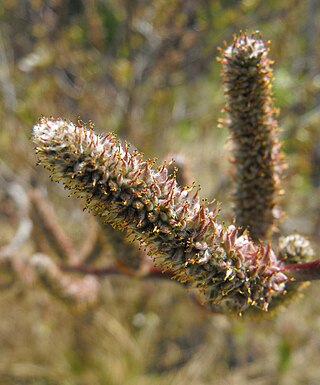
Salix breweri is a species of willow known by the common name Brewer's willow. It is endemic to California, where it can be found in the serpentine soils of the Coast Ranges in and around the San Francisco Bay Area. It is a riparian shrub growing one to four meters in height. The yellowish or reddish brown stems are lightly hairy in texture, the small twigs coated in velvety fibers. The leaves are generally lance-shaped, smooth-edged or gently toothed, and partially rolled under along the edges. The leaves are hairy, with the lower surfaces often quite woolly. Mature leaves may be 14 centimeters long or more. The inflorescence is a catkin which develops before the plant produces leaves. The catkins are up to 5 or 6 centimeters long, the female ones lengthening further as the fruits develop.

Packera breweri is a species of flowering plant in the aster family known by the common name Brewer's ragwort. It is endemic to central California, where it occurs in the woodlands and grasslands of the Central Coast Ranges. They are more frequently found in mid-southern counties of California near the coast, such as Kern or Monterey.
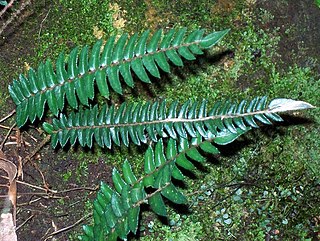
Pellaea nana, known as dwarf sickle fern, is a fern species in the subfamily Cheilanthoideae of the family Pteridaceae. It grows in eastern Australia, in rainforest or moist eucalyptus forest, often on rocks, cliffs and large boulders. Also found growing on Lord Howe Island. The original specimen was collected by Allan Cunningham at the Brisbane River. In the state of Victoria, this plant is considered rare. The specific epithet nana is derived from the Latin word nanus meaning dwarf.
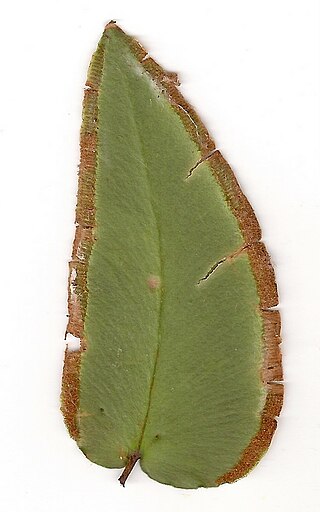
Pellaea paradoxa is a small hardy fern found north of Sydney in eastern Australia and Lord Howe Island. Often growing in or near rainforests in rocky crevices. But it may occasionally be seen in drier areas. Fronds are usually curved, 4 to 9 cm long, and 1 to 4 cm wide. Leathery to touch and a dull green. Juvenile fronds may be heart shaped. The stalks are around 1 to 5 mm long. Sori appear in a band, usually 2 to 3 mm wide, at the edge of the underside of the fronds.

Myriopteris alabamensis, the Alabama lip fern, is a moderately-sized fern of the United States and Mexico, a member of the family Pteridaceae. Unlike many members of its genus, its leaves have a few hairs on upper and lower surfaces, or lack them entirely. One of the cheilanthoid ferns, it was usually classified in the genus Cheilanthes as Cheilanthes alabamensis until 2013, when the genus Myriopteris was again recognized as separate from Cheilanthes. It typically grows in shade on limestone outcrops.
Myriopteris allosuroides is a moderately-sized fern of Mexico, a member of the family Pteridaceae. Unlike many members of its genus, its rachides are grooved on the upper surface and largely free of hairs or scales. One of the cheilanthoid ferns, it was usually classified in the genera Cheilanthes or Pellaea until 2013, when the genus Myriopteris was again recognized as separate from Cheilanthes. It typically grows on dry, rocky slopes over acidic, particularly basaltic, rock.
Argyrochosma connectens is a small cheilanthoid fern endemic to Sichuan, China. It is the only member of its genus known from Asia. Relatively rare, it is found growing in the crevices of limestone rocks in hot, dry valleys. The species was long classified in the genus Pellaea, but after a phylogenetic study in 2015 was transferred to Argyrochosma.

Myriopteris scabra, previously known as Pellaea scabra, Cheilanthes aspera or Cheilanthes horridula, is a species of cheilanthoid fern with the common name rough lipfern. It is native to Mexico and to Texas in the United States.


















